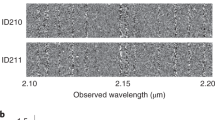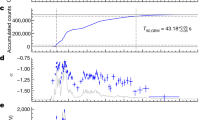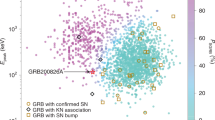Abstract
Although more than 2,000 astronomical γ-ray bursts (GRBs) have been detected, and numerous models proposed to explain their occurrence1, they have remained enigmatic owing to the lack of an obvious counterpart at other wavelengths2–5. The recent ground-based detection6,7 of a transient optical source in the vicinity of GRB970228 (refs 8–11) may therefore have provided a breakthrough. The optical counterpart appears to be embedded in an extended source which, if a galaxy as has been suggested7,12, would lend weight to those models that place GRBs at cosmological distances. Here we report observations using the Hubble Space Telescope of the transient counterpart and extended source 26 and 39 days after the initial γ-ray outburst. We find that the counterpart has faded since the initial detection (and continues to fade), but the extended source exhibits no significant change in brightness between the two dates of the observations reported here. The size and apparent constancy of the extended source imply that it is extragalactic, but its faintness makes a definitive statement about its nature difficult. Nevertheless, the decay profile of the transient source is consistent with a popular impulsive-fireball model13, which assumes a merger between two neutron stars in a distant galaxy.
This is a preview of subscription content, access via your institution
Access options
Subscribe to this journal
Receive 51 print issues and online access
$199.00 per year
only $3.90 per issue
Buy this article
- Purchase on Springer Link
- Instant access to full article PDF
Prices may be subject to local taxes which are calculated during checkout
Similar content being viewed by others
References
Nemiroff, R. J. A century of gamma ray burst models. Comments Astrophys. 17, 189–205 (1994).
Fishman, G. J. & Meegan, C. A. Gamma-ray bursts. Annit. Rev. Astron. Astrophys. 33, 415–458 (1995).
Hurley, K. in Gamma Ray Bursts (eds Paciesas, W. & Fishman, G.) 3–12 (Conf. Proc. 265, Am. Inst. Phys., New York, 1992).
Higdon, J. & Lingenfelter, R. Gamma-ray bursts. Annu. Rev. Astron. Astrophys. 28, 401–436 (1990).
Hartman, D. in The Gamma Ray Sky with COMPTON and SIGMA (eds Signore, M., Salati, P. & Verdrenne, G.) 329–367 (NATO ASI Proc. Kluwer, Dordrecht, 1995).
Groot, P. J. et al. IAU Circ. No. 6584 (1997).
van Paradijs, J. et al. Transient optical emission from the error box of the γ-ray burst of 28 February 1997. Nature 386, 686–689 (1997).
Costa, E. IAU Circ. No. 6572 (1997).
Costa, E. et al. IAU Circ. No. 6576 (1997).
Cline, T. L. et al. IAU Circ. No. 6593 (1997).
Hurley, K. et al. IAU Circ. No. 6594 (1997).
Metzger, M. R. et al. IAU Circ No. 6588 (1997).
Meszaros, P. & Rees, M. Optical and long-wavelength afterglow from gamma-ray bursts. Astrophys. J. 476, 232–235 (1997).
Sahu, K. C., Livio, M., Petro, L. & Macchetto, F. D. IAU Circ No. 6606 (1997).
Sahu, K. C., Livio, M., Petro, L. & Macchetto, F. D. et al. IAU Circ No. 6619 (1997).
Frail, D. A. et al. IAU Circ No. 6576 (1997).
Groot, P. J. et al. IAU Circ No. 6574 (1997).
Margon, B., Deutsch, E. W. & Seeker, J. et al. IAU Circ No. 6577 (1997).
Pederson, H. et al. IAU Circ No. 6580 (1997).
Wagner, R. M. & Buie, M. W. et al. IAU Circ No. 6581 (1997).
Wagner, R. M., Foltz, C. B. & Hewett, P. et al. lAU Circ. No. 6581 (1997).
Metzger, M. R. et al. IAU Circ No. 6582 (1997).
Biretta, J. A. et al. WFPC2 Instrument Handbook Version 4.0 (Space Telescope Science Inst, Baltimore, 1996).
Warner, B. Cataclysmic Variable Stars 261 (Cambridge Univ. Press, 1995).
Warner, B. Cataclysmic Variable Stars 148 (Cambridge Univ. Press, 1995).
Mirzoyan, L. V. in Flares and Flashes (eds Greiner, J., Duerbeck, H. W. & Gershberg, R. E.) 47–54 (Springer, Berlin, 1995).
Panagia, N. in Supernova 1987A in the Large Magellanic Cloud (eds Kafatos, M. & Michalitsianos, A. G.) 96–105 (Cambridge Univ. Press, 1988).
Panagia, N. et al. Coordinated optical, ultraviolet, radio, and X-ray observations of Supernova 1979c in M100. Man. Not. R. Astron. Soc. 192, 861–879 (1980).
Perlmutter, S. et al. A supernova at z = 0.458 and implications for measuring the cosmological deceleration. Astrophys. J. 440, L41–L44 (1995).
Perlmutter, S. et al. Measurements of cosmological parameters Omega and Lambda from the first 7 supernovae at z > 0.35. Astrophys. J. (in the press).
Podsiadlowski, P., Rees, M. & Ruderman, M. Gamma-ray bursts and the structure of the galactic halo. Mom. Not. R. Astron. Soc. 273, 755–771 (1995).
Mao, S. & Paczynski, B. On the cosmological origin of gamma-ray bursts. Astrophys. J. 388, L45–L48 (1992).
Katz, J. Two populations and models of gamma-ray bursts. Astrophys. J. 422, 248–259 (1994).
Lamb, D. Q. in Neutron Stars: Theory and Observation (eds Ventura, J. & Pines, D.) 545–560 (Kluwer, Dordrecht, 1991).
Hakkila, J., Myers, J. M., Stidham, B. J. & Hartman, D. H. A computerized model of large-scale visual interstellar extinction. Astron. J. (submitted).
Williams, R. E. et al. The Hubble deep field: observations, data reduction, and galaxy photometry. Astron. J. 112, 1335–1389 (1996).
Carter, B. Cosmic gamma-ray bursts from black hole tidal disruption of stars? Astrophys. J. 391, L67–L70 (1992).
Liang, E., Kusunose, M., Smith, I. A. & Crider, A. Physical model of gamma-ray burst spectral evolution. Astrophys. J. 479, L35–l38 (1997).
Galama, T. et al. The decay of optical emission from the γ-ray burst GRB970228. Nature 387, 479–481 (1997).
Paczyński, B. Gamma-ray bursters at cosmological distances. Astrophys. J. 308, L43–L46 (1986).
Eichler, D., Livio, M., Piran, T. & Schramm, D. Nucleosynthesis, neutrino bursts, and γ-rays from coalescing neutron stars. Nature 340, 126–128 (1989).
Phinney, E. S. The rate of neutron star binary mergers in the universe: minimal predictions for gravity wave detectors. Astrophys. J. 380, L17–L21 (1991).
Narayan, R., Piran, T. & Shemi, A. Neutron star and black hole binaries in the Galaxy. Astrophys. J. 379, L17–L21 (1991).
Groot, P. J. et al. IAU Circ. No. 6588 (1997).
Author information
Authors and Affiliations
Rights and permissions
About this article
Cite this article
Sahu, K., Livio, M., Petro, L. et al. The optical counterpart to γ-ray burst GRB970228 observed using the Hubble Space Telescope. Nature 387, 476–478 (1997). https://doi.org/10.1038/387476a0
Received:
Accepted:
Issue Date:
DOI: https://doi.org/10.1038/387476a0
This article is cited by
-
The key role of BeppoSAX in the GRB history
Rendiconti Lincei. Scienze Fisiche e Naturali (2019)
Comments
By submitting a comment you agree to abide by our Terms and Community Guidelines. If you find something abusive or that does not comply with our terms or guidelines please flag it as inappropriate.



